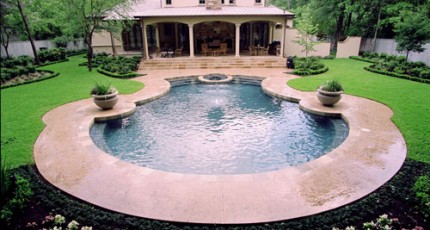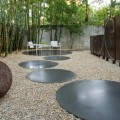Pool Restoration

Swimming pool restoration is not as extensive as swimming pool renovation. It is a more superficial remake of surfaces and finishes. By superficial we do not mean that it lacks significance in the grand scheme of landscape design. On the contrary, swimming pool restoration is of vital importance because it maintains the beauty of one of the most significant focal points in the backyard landscape.
The intent here is to create an aesthetic that stands out in its environment. Many older pools that were designed in the 70s and 80s were built with standard-grade materials which were rather lackluster to begin with. Over time, these materials become weather-beaten and even less attractive. Restoring a bright, cosmetic appearance to these surfaces can make an otherwise ordinary pool look extraordinary without having to go through the complications and exorbitant expenses that a complete renovation would entail.
One of the most important components of swimming pool restoration is bringing plumbing and electrical systems up to code. Years ago, it was discovered that the powerful suction of pool drains could be fatal if a person got to close to the drain and was sucked into its force. Codes were written to mandate that two drains be installed in every pool. This reduced the force of each individual drain, and it further minimized risk by also mandating that drains be so many feet apart at the bottom of the pool.
Over the years the minimum distance allowed between pool drains has increased to further make the pool environment safe for adults and children. Any time we undertake a pool restoration project we must check to see if the distance between drains needs to be increased. We must also check the electrical systems to make sure they are properly wired and safe from short circuit. Many people who contact us for this service have no idea that these systems are in need of overhaul. They initially contact us for aesthetic purposes, only to be pleasantly surprised to learn that we can not only make their pool look better, but also operate more safely.
Of course, we also take care of any aesthetic needs when we are working on an older pool. The plaster within the pool is almost always redone-particularly when we redo the plumbing within the shell. It also adds color and sheen to the pool interior, which adds dimension and mystique when illuminated by pool lights at night.
Tile is also commonly replaced when we undertake a swimming pool restoration project. Tile normally is found where the water meets the plaster and extends upward to the base of the coping. Pools that were built in the 1970s and 1980s tend to feature colors and textures that are dated to those periods in history. Replacing these tiles with something more chic and universal in aesthetic ensures that the pool with look better today, and continue to look better tomorrow.
Our experience in outdoor architecture and custom hardscape design helps us better match appropriate tile textures and colors to surrounding patio design, outdoor buildings, home architecture, and garden design. We do the advance planning work for the client by choosing the best materials, colors, and textures that will appropriately compliment the elements that surround the immediate vicinity of the pool. We then sit down with our clients, and we discuss each one of these options in detail.
At this point in the swimming pool restoration process we take on a very consultative function in the development of landscape architecture. Our job is not to tell the client what they have to do, but rather to frame the project for the homeowners and let them consider which of our professionally-recommended choices will best suit the needs of their custom swimming pool.
Once tile material, color, and texture have been selected, we then discuss options for new coping. Any number of materials can be used to build this very significant swimming pool element. Coping serves both a decorative role and a very important functional role as a major determining factor in elevation. We may discover, for example, that swimming pool remodeling will require lowering the elevation of the deck, but at the same time we may realize that this simply is not an option. By changing the elevation of the coping, we can change the elevation of approach and effectively work around what otherwise would be an insurmountable barrier.
Both the design elements and the finer details of swimming pool restoration are discussed and finalized before implementing redesign. We recommend that clients consider upgrading their patio and adjacent garden design at this time as well. This will ensure a better continuity of new aesthetics throughout the back yard proper, and it will further magnify the restoration work we do on the pool by creating complimentary forms and structures in the immediate environment.





